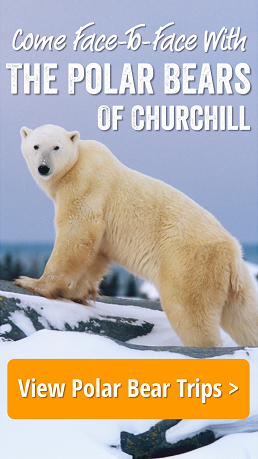by Steve Selden | Jan 21, 2011 | Tour News
Polar bears are out on the ice in the Hudson Bay hunting seals. At least in the Western Hudson Bay. The Eastern coast and extending out some distance has been lacking in ice as a result of weather patterns, currents and an unusually late freeze-up in the bay overall. As a result bear population on the Western half is more saturated.

Photo: Steve Selden
The weather is settling back into normal, frigid Winter conditions as mentioned in my last post. Despite some Churchillians claim that this winter has been “warm”..yes warm, the temperatures are currently in the -30C range almost daily. The outlook for the next week or so is for the mercury to drop close to -50C with winds of 60 kilometers …more like the mean for January in the North. With extended cold such as this, the Eastern Hudson Bay should play catch -up fairly quickly. Seal populations should remain steady as they will still have ample birthing platform available to the West. This condensed area could be opportunity for polar bears to have a solid Winter of energy storage. Should be interesting to observe their weights this Summer.

Photo: Steve Selden
With the good also comes..well…the not so good. Unless your an Inuit hunter holding a polar bear tag this Winter. Hunting around Baffin Island and the Davis Straits has commenced with quotas increased this year. Limits on takes have increased from 16 males and seven females to 32 males and nine females. The Inuit contend that unused tags from previous years are being totaled for this year’s limit rather than an increase in quota overall. I’ll dig up more information on this and keep you all informed in future posts. It will be interesting to see how ice conditions factor into this year’s hunt as well.
CBC News Story On Iqaluit Polar Pear Quota Increase
by Steve Selden | Jan 12, 2011 | Tour News
Winter has settled in to a more predictable pattern in Churchill these days with temperatures consistently in the -25C range. Snow has been falling for the last day or so though the outlook for the rest of the week is clear and cold. Ice coverage in the Hudson Bay is catching up quickly to the mean for this time of year and polar bears are surely happy with that fact. Occasional spectacular Aurora Borealis (Northern lights) displays have been making their appearance…as the “high” season for viewing this amazing phenomena, approaches. Soon brave travelers from across the world will be coming to Churchill in February to take it all in. I’ll keep you updated on the action in the sky as well as daytime activities on the snowy tundra.

Photo: Colby Brokvist
Continuing with our recap of this past polar bear season in photo’s, here are a few more images to remember it by. These were some beautiful shots captured by people close to the bears. They tell the story of some trends we saw throughout a weird, unique season.

Photo: Paul Brown
In a season when ice coverage in the bay was at least two weeks behind the norm in the month of November, numerous seal kills were documented with polar bears feeding on the carcasses. For some bears this pre-season sustenance can be the bridge to survival. Are the bears adjusting to shorter ice seasons with keener hunting techniques or are more seals being pushed on land due to the lack of early ice formation?
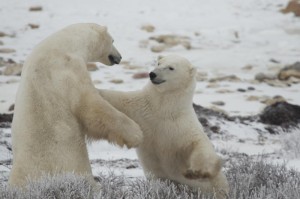
Photo: Paul Brown
Sparring was a featured occurrence for travelers virtually every day once the season was in full gear. Male bears were overall regarded in healthy shape and willing to exert their precious energy while waiting on the tardy ice to form. Even females were observed roughing it up as agitation in a crowded Churchill Wildlife Management Area escalated.
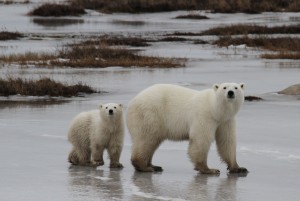
More sows with cub(s) were reported than in past years. Not sure if this signifies anything or not but it did make for a widely diverse behavioral stage on the tundra. There was also more aggressive action by male bears toward the mom’s with cubs….only natural.
by Steve Selden | Jan 4, 2011 | Tour News
The new year has started with much colder temperatures and light snow from time to time. Currently the temperature range has been in the -15C to -20C range with the wind chill approaching -30C. Sunrise is just past 9am and sunset just after 3:30pm in the afternoon…short days though more than farther Northern arctic communities.
With the new year upon us, I’d like to look back at some of the fantastic photo’s in two or three parts from polar bear season and recap some of the highlights as we sit back while the bears are out on the ice gaining sustenance. I will present the pics in order of what I thought were most incredible. Ok, here we go.
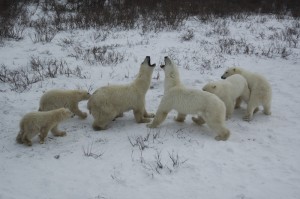
Photo: Curtis Bouvier

Photo: Curtis Bouvier
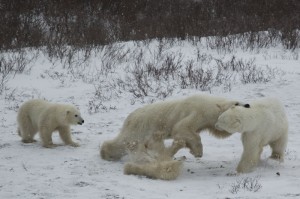
Photo: Curtis Bouvier
These three photo’s have to be shown together in sequence to get a complete grasp on the encounter’s intensity. These were taken by Curtis Bouvier who is the nephew of good friend and long -time rover driver and tundra lodge manager Ed Bouvier. Ed has left Churchill while his nephew drove a rover this past season. These are truly unique and rare photo’s as this scene has not been seen by anyone I have been in contact with who lives or works in Churchill.
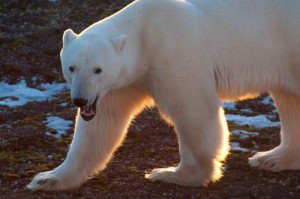
Photo: Colby Brokvist
In a season when the snow and cold stayed away early on, bears were viewed in a different light…such as this magnificent aura framing the bear. Sometimes, the contrast of the darker tundra can allow for more crisp shots without the glare of total white.
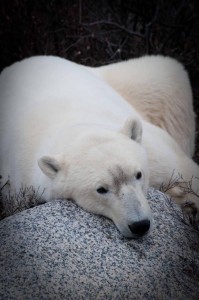
Photo: Colby Brokvist
Another by Natural Habitat guide Colby Brokvist. This one illustrates just how soft those Northern rocks (not Eric) are…it’s a little known fact.
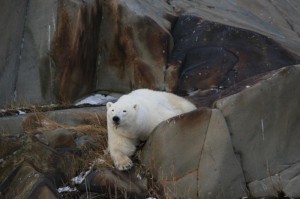
Photo: Paul Brown
Our final photo for this segment is one by Natural Habitat Guide Paul Brown. This huge male perched in Precambrian shield granitoid rocks, feels solid and heavy. The shapes of the rocks juxtaposed against the mammoth bear are reminiscent of the iconic Henry Moore bronze abstract sculptures.
by Steve Selden | Dec 28, 2010 | Tour News
All quiet on the Western front…of the Hudson Bay that is… in Churchill, Manitoba. And, fairly warm for December for sure. Temperatures in the mid-teens persisted throughout the week. As the polar bear season becomes a distant memory for all, the town itself has slowed to a crawl despite the heat wave of sorts. 
Most of the restaurants and a good many hotels have shut their doors for the Winter. Gypsy’s Bakery closed on November 30th and will re-open in early Spring. While the local mainstay has stayed open much later in recent years, sometimes through Christmas, the DaSilva family opted to close slightly earlier this time around…maybe to head back to visit family in Portugal for the holiday’s. Really, the only larger establishment in town still open is the Seaport hotel and restaurant on Kelsey Boulevard in the center of town. Mayor Mike Spence and his wife Lawreen have made a commitment to remain open for townspeople and Winter travelers all year long….the hot coffee flows all day.
While the recent warmth has allowed local Churchillians to roam the land in the region without much discomfort, the polar bears are surely gone for now. The open water leads in the Hudson Bay are a product of the flowing river water emptying into the bay. However, the bay in general to the North, has supported enough ice to allow the bears to pursue their Winter diet of ringed seals. Open water on the Western half of the Churchill River has forced avid outdoors men and women to track further up-river to cross on snow machines. The increased current and tide flow nearer the port affect ice formation and thus passage across this time of year. Some locals maintain rustic cabins across river scattered on the tundra…used as get-away respites from the hustle and bustle of metropolitan Churchill proper. The old White Whale Lodge that used to be nestled in the sandy dune of the river bank almost directly across from the grain port, used to feel like a million miles away from civilization. Unfortunately flames reduced the structure to ashes some years ago.
While things are slow in Churchill over the next several weeks, I would like to give you all some characteristics of the “other” inhabitants of the region that don’t quite get the press that the majestic polar bears do. No..not the local people…although I will , from time to time, bring their stories to light as well. Their are a number of animal species that ride out the brutally cold Winter days either by choice or evolutionary ties. I’m sure describing some of their behavioral habits will open your eyes to their strength and perseverance.
Our first, the gray jay or whiskey jack,..from the family Corvidae, which includes ravens, jays,magpies and nutcrackers are widespread in the forested areas of Churchill. Anyone who has taken a dogsled excursion from one of the local operators has surely observed this bird flitting away and back around the base camp. Natural scavengers at heart, the name whiskey jack is derived from an Algonquin name -Wisakedjak- for a mischievous and disobedient mythical creature. One surely gets this feeling from the body language and vocalizations of this bird.

Gray jays mate for life and are territorial in feeding and nesting habits. Because they do not migrate or interbreed among their species, they are well adapted to specific local cold conditions as well as short growing seasons. They feed on a wide variation of insects, small animals such as frogs and moles as well as mushrooms, seeds and berries. Well adapted gray jays are able to reproduce at a relatively early point in the “season”. Between two and five eggs are laid as early as February when most if not all of their natural food source remains out of reach. What’s their secret?
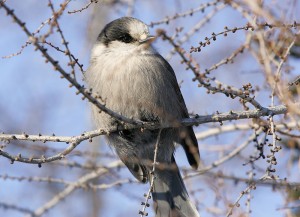
Photo: Eric Rock
As a guide for over 15 years in the Churchill region, the word I spoke most often to travelers was “adaptability” or some form of it. Every living being, including humans, living in the North has to find ways to adapt to life there on a constant daily basis. The ones that cannot are forced to leave or die..the ones that can, find their spirit.
Gray jays spend most of the year preceding reproduction harvesting their food for Winter. They work countless beak-fulls of food into a sticky paste moistened by saliva. They cache these life giving treasures in a mentally mapped network of hidden places. Usually these spots are under flakes of spruce bark or amongst needles on evergreen branches safe from drifting snow or predators. These stored packets allow the jays a head start to life in the region before any of their migrant winged counterparts return from their warm Winter ranges much further South. Not everyone can afford a tropical home as you know. So instead of exhausting all that energy flying thousands of miles, gray jays opt for solace in the splendid boreal forests of the arctic landscape.
by Steve Selden | Dec 16, 2010 | Tour News
Snow accumulating up to 15cm (just over five inches) over the next few days will give the region a little more of a Winter look… contrary to the feel Churchillians are getting from the continued “warmer” air temperatures that have returned once more. Temperatures are now hovering just below the freezing mark with not a whole lot of existing snow- cover. Although the wind-chill surely won’t allow for tee shirts and shorts, nobody seems to be complaining about the October-like reprieve.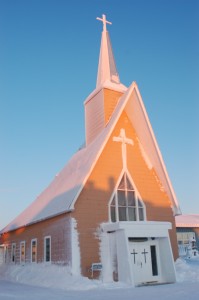
Local Dene elder Caroline Bjorklund was out riding around with a friend and they came across an arctic hare scampering around the outskirts of town. A few foxes, of the red and arctic variety, also were out looking to take advantage of the shallow snow cover and store up some last energy morsels before the inevitable turn to true Winter conditions. Although polar bears have not been spotted recently, Caroline and friend saw some fresh paw tracks just near the grain elevator at the port.
The relationship between bears and people in Churchill is truly a strange, dichotomous one. Without polar bears the town would surely be quite different…..and, although locals by and large are not big polar bear lovers due to the safety risk, the bears seem to be the heart and soul of the town. When they are mostly gone in late November, stories of finding fresh tracks or hearing Manitoba Conservation cracker shells echo in the distance ring like forlorn tales of lost friends. After all, the two month focus on polar bears surely is exciting and once done the void seems great. The sensation one feels after losing a limb…feeling the appendage is still there…is probably not an apt analogy but I think you get the idea, eh?
The Churchill Northern Studies Center is nearing the completion of its’ massive reconstruction project way out East at the end of the highway. A new state of the art research and housing facility is hoped to be finished by Spring.The building looks like a grounded “Noah’s Arc” according to Caroline Bjorklund and other locals. I guess if global warming accelerates considerably in the future, Churchillians and the researchers will all be in the same “boat”. Now that would be some reality series.
The Northern Studies Center and Parcs Canada are conducting a science symposium in Winnipeg on January 19-21, 2011. Each year the Churchill Northern Studies Centre hosts a Research Symposium in southern Manitoba and every other year Parks Canada hosts a Wapusk National Park Research and Monitoring Meeting. This year the two have joined together to present a CNSC-PC two day science symposium. It will be a platform for researchers to present and discuss ongoing and completed projects worked on this past year. For more details go to the center’s website at churchillscience.ca.





















